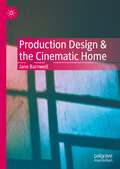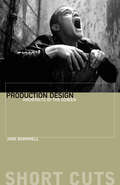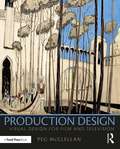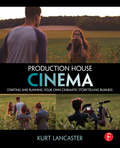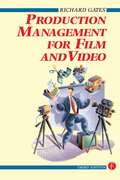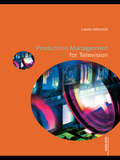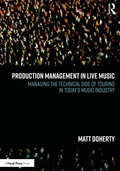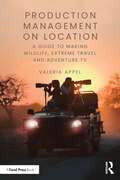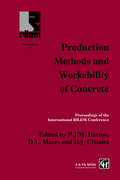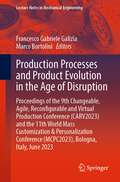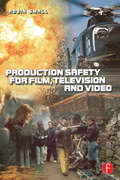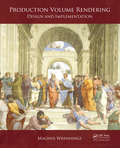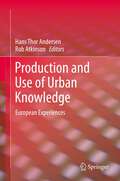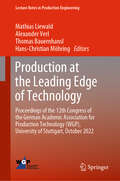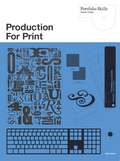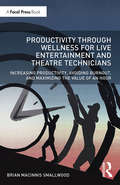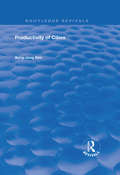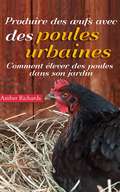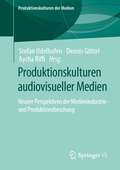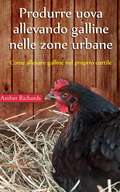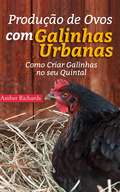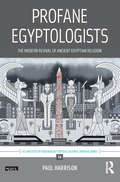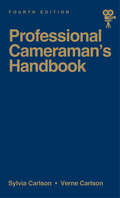- Table View
- List View
Production Design & the Cinematic Home
by Jane BarnwellThis book uses in-depth case studies to explore the significance of the design of the home on screen. The chapters draw widely upon the production designer’s professional perspective and particular creative point of view. The case studies employ a methodology Barnwell has pioneered for the analysis of production design called Visual Concept Analysis, which can be used as a key to decode the design of any given film. Through the nurturing warmth of the Browns’ home in Paddington, the ambiguous boundaries of secret service agent homes in Tinker Tailor Soldier Spy and the ‘singleton’ space occupied by Bridget Jones, Barnwell demonstrates that the domestic interior consistently plays a key role. Whether used as a transition space, an ideal, a catalyst for change or a place to return to, these case studies examine the pivotal nature of the home in storytelling and the production designers’ significance in its creation. The book benefits from interviews with production designers and artwork that provides insight on the creative process.
Production Design: Architects of the Screen (Short Cuts)
by Jane BarnwellProduction Design: Architects of the Screen explores the role of the production designer through a historical overview that maps out landmark film and television designs. From the familiar environs of television soap operas to the elaborate and disorientating Velvet Goldmine. Jane Barnwell considers how themes. motifs and colours offer clues to unravel plot. character and underlying concepts. In addressing the importance of physical space in film and TV, the book investigates questions of authenticity in detail. props. colours and materials. The design codes of period drama. more playful representations of the past and distinctive contemporary looks are discussed through the use of key examples ranging from musicals of the 1930s to cult films of the 1990s. The book also includes interviews with leading production designers and studies of Trainspotting, The English Patient and Caravaggio.
Production Design: Visual Design for Film and Television
by Peg McClellanProduction Design: Visual Design for Film and Television is a hands-on guide to the craft of Production Design and Art Direction. Author Peg McClellan gives an insider’s view of the experiences and challenges of working as a Production Designer in film and television. The book covers three major areas, starting with an overview and the basics of job responsibilities, the artistic approach and the background which every Production Designer needs to be familiar with, and progressing to the mechanics of the role with a day-to-day breakdown of the job itself. McClellan takes you through script analysis, team collaborations, the hierarchy of a production, hiring a team, the business elements, locations, studio facilities, handling change, and everything in between. With case studies, insights from successful Production Designers, and inspiration in the form of over 200 colour photos and illustrations from storyboards to sets, this is the ideal book for students seeking a career in production design, and professionals looking to further their design knowledge.
Production House Cinema: Starting and Running Your Own Cinematic Storytelling Business
by Kurt LancasterIn Production House Cinema: Starting and Running Your Own Cinematic Storytelling Business, renowned video storyteller Kurt Lancaster offers both students and professionals a practical guide to starting their own video production company and creating cinematic, client-based video content. Utilizing practical know-how along with in-depth analysis and interviews with successful independent production houses like Stillmotion and Zandrak, Lancaster follows the logistics and inspiration of creating production house cinema from the initial client pitch all the way through financing and distribution. The book includes: An examination of the cinematic and narrative style and how to create it; A discussion of the legal procedures and documents necessary for starting and operating a production house; Advice on crafting a portfolio, reel, and website that both demonstrates your unique style and vision and attracts clients; A guide to the financial business of running an independent production house, including invoicing, accounting, and taxes—and how much you should charge clients; Tips for how to better communicate with clients, and how to develop and shape a client’s story; A breakdown of how to select the right gear and equipment for a shoot, on budget; Cinematic case studies that offer detailed coverage of several short films made for clients.
Production Management for Film and Video
by Richard GatesPacked with step by step information, hints and tips, this book provides all the basic information needed to production manage a film or video from beginning to end - from idea to delivery. Production Management for Film and Video gives all the basic information needed to production manage a film or video from beginning to end - from idea to delivery.Aspiring young film producers, programme makers and students of film or video production will find this an essential source of information, as indeed will anybody wishing to improve their knowledge and skills in the field. One is guided from the script or proposal, right through the various stages of production management to include:· script breakdown· crossplotting· scheduling· budgeting· preparation· the shoot· editing and post-production· deliveryNow in its third edition, Production Management for Film and Video has been further revised to include: · information on health and safety requirements· the need to be aware of computer generated imagery · the effect this kind of programme making has on schedules and budgets. Different kinds of management for different productions are also covered - from features through to documentaries - and advice is offered on how to run a production more effectively. Examples, taken from actual productions, demonstrate the kind of documentation needed to develop, run and control a production. Emphasis is placed on the basic principles of good management that apply to all the different kinds of film that can be produced.Richard Gates is a freelance producer/production manager and has been involved in over 40 productions of different kinds. He also lectures extensively on production and production management techniques.
Production Management for Television (Media Skills)
by Leslie MitchellCompletely up to date with relevant information on digital technology and HD TV, this is the only title to focus specifically on television production management, and presents an easily accessible and authoritative guide to the area. Production Management for Television provides a reliable, factual and theoretical framework for an understanding of production management. It includes a reference directory of agencies and organizations, and addresses and contacts for training. Subjects covered include: • the main responsibilities of the production manager• key skills needed by the production manager• routine procedures• appropriate paperwork and record keeping• health and safety issues• rights management• career structure and development for production managers• useful references and further information. The book is supported by a companion website at www.routledge.com/textbooks/9780415424813.
Production Management in Live Music: Managing the Technical Side of Touring in Today’s Music Industry
by Matt DohertyProduction Management in Live Music: Managing the Technical Side of Touring in Today’s Music Industry is a handbook for the aspiring production manager looking to forge a career in the live music industry. This book outlines the role that a production manager performs and their key responsibilities, and takes the reader step by step through the entire process of preparing a show for a tour. From dealing with artists and management to hiring crew, from booking vendors and scheduling the day-to-day of a busy tour, this text covers everything that is needed to take the show into rehearsals and finally on the road. Every aspect of the job is covered, including the very important challenges that face today’s industry in the realms of sustainability, inclusion, diversity and mental health. Whether the show be on a festival, in a small theatre or club, or in a modern arena, this book clearly lays out the tasks and challenges and offers practical solutions to ensure the smooth running of a live performance. Production Management in Live Music is written for students in stage and production management courses and emerging professionals working in live music touring.
Production Management on Location: A Guide to Making Wildlife, Extreme Travel and Adventure TV
by Valeria AppelProduction Management on Location is your essential companion for mastering the complexities of international documentary production. Written by an experienced production manager who has spent years on location, this book offers a rare, hands-on look at the realities of producing unscripted documentaries in diverse global settings.From adrenaline-fueled adventures to projects featuring celebrity presenters, this guide demystifies the process of prepping, producing, and managing on-location shoots. Whether you're coordinating a small crew or handling high-profile talent, you'll find step-by-step guidance on pre-production planning, logistical coordination, and managing people under demanding circumstances. Featuring exclusive case studies and interviews with award-winning professionals and presenters, the book brings firsthand insights and practical advice from the field. It also delves into the latest trends in production, including sustainability practices and innovations that are becoming essential to good production management.Packed with actionable strategies and behind-the-scenes know-how, this is perfect for emerging and experienced professionals, documentary filmmakers, and students interested in documentary production.
Production Methods and Workability of Concrete
by P.J.M. Bartos D. L. Marrs D. J. ClelandPractical production of ordinary and special, high performance concretes and their behaviour and properties when fresh are the main themes of this book. It derives from the International RILEM Conference held in Paisley, Scotland in June 1996, and represents the culmination of the work of two RILEM Technical Committees (145 WSM Workability of Speci
Production Processes and Product Evolution in the Age of Disruption: Proceedings of the 9th Changeable, Agile, Reconfigurable and Virtual Production Conference (CARV2023) and the 11th World Mass Customization & Personalization Conference (MCPC2023), Bologna, Italy, June 2023 (Lecture Notes in Mechanical Engineering)
by Francesco Gabriele Galizia Marco BortoliniThis book includes state-of-the-art and original research contributions from two well-established conferences, which collectively focus on the joint design, development, and management of products, advanced production systems, and business for sustainable customization and personalization. The book includes wide range of topics within these subjects, ranging from industrial success factors to original contributions within the field. The authors represent worldwide leading research institutions.
Production Safety for Film, Television and Video
by Robin SmallCovering all aspects of production safety, this is an invaluable reference guide for the independent programme maker, freelancer, manager, producer, tutor and student filmmaker. Robin Small identifies all the major risks and gives advice on how to control and/or eliminate them. Each hazard section includes useful references to the relevant legislation, documents and licences, as well as addresses of organisations for essential advice and recommended further reading. An appendix lists samples of vital certificates, with visual references provided on www.focalpress.com. Important information about hazard identification, risk assessment and safety policy is provided in the chapters covering legislation, health and safety management, personal protective equipment and insurance. Particular hazards are then split into individual sections for ease of reference. These hazards include:AsbestosCranesExplosives and pyrotechnicsFood and cateringManual handing and liftingVisual display screensWorking at heightsThe appendices provide comprehensive contact information for UK and European Heath and Safety sources. They also include sample forms to draw up your own safety system.Robin Small is Senior Lecturer in Television, Media Department at the University of Huddersfield.
Production Volume Rendering: Design and Implementation
by Magnus WrenningeDue to limited publicly available software and lack of documentation, those involved with production volume rendering often have to start from scratch creating the necessary elements to make their system work. Production Volume Rendering: Design and Implementation provides the first full account of volume rendering techniques used for feature anima
Production and Use of Urban Knowledge
by Hans Thor Andersen Rob AtkinsonThis book provides new insights on cities and the nature of urban development, and the role of knowledge management in urban growth. It considers how knowledge informs policies and supports decision making, and can assist in addressing the drivers of urban change. The way that knowledge is produced and used in urban development is analysed, with examples drawn from a range of European countries. This book illustrates how the development and implementation of policies for urban areas can draw on knowledge management, even as the knowledge economy itself stimulates the evolution of the city as a place of innovation and creativity. Whilst knowledge grows in importance, so do urban issues, particularly in economic and political contexts at both European and national levels. These essays explore growth in the range of knowledge available in urban contexts, the ways to generate new knowledge from a wide range of stakeholders, and how these can make an effective contribution to decision making processes in urban development. The attractiveness of cities and surrounding areas to knowledge based forms of industry and investment and the competitiveness and performance of cities are a matter of major concern for national governments. In a sense it has become too important to leave to city politicians, and it is a topic requiring sustained reflection. This book gives the reader a detailed understanding of the issues involved and prompts further reflections.
Production at the Leading Edge of Technology: Proceedings of the 12th Congress of the German Academic Association for Production Technology (WGP), University of Stuttgart, October 2022 (Lecture Notes in Production Engineering)
by Thomas Bauernhansl Alexander Verl Mathias Liewald Hans-Christian MöhringThe German Academic Association for Production Technology (WGP) annually invites researchers coming from its institutes and from industry to contribute peer reviewed papers in the field of production technology. This congress proceedings provides recent research results and findings on leading-edge manufacturing processes. Main aim of this scientific congress is to push forward existing borders in production and to provide novel solutions of "Production at the Leading Edge of Manufacturing Technology”. Different sessions were held on the topics• Recent Developments in Manufacturing Processes• Advancements in Production Planning• New Approaches in Machine Learning• Aspects of Resilience of Production Processes• Creating Digital Twins for Production
Production for Print
by Mark GatterThis book gives designers the confidence to do everything necessary to ensure trouble-free, high-quality printing – to calibrate images (colour and black and white); adjust trapping levels in all the major software applications, and mix colours that won't print as something that is a complete surprise. It explains scanning and resolution, and discusses good and bad image formats, describing techniques to make images look good in print – even if they have been downloaded from the internet. There is advice on how to get accurate quotes from a printer, a checklist to use when sending a job to print and a glossary of print production terms. Changes to new edition:* Text fully updated to take account of new developments in print technology and software * 22,000 words of new/replacement text * Completely redesigned in Portfolio Skills series, with new cover * Many new colour illustrations added to make book more visual * All screen grabs now translatable
Production for Print (Portfolio Skills)
by Mark GatterThis book gives designers the confidence to do everything necessary to ensure trouble-free, high-quality printing – to calibrate images (colour and black and white); adjust trapping levels in all the major software applications, and mix colours that won't print as something that is a complete surprise. It explains scanning and resolution, and discusses good and bad image formats, describing techniques to make images look good in print – even if they have been downloaded from the internet. There is advice on how to get accurate quotes from a printer, a checklist to use when sending a job to print and a glossary of print production terms. Changes to new edition:* Text fully updated to take account of new developments in print technology and software * 22,000 words of new/replacement text * Completely redesigned in Portfolio Skills series, with new cover * Many new colour illustrations added to make book more visual * All screen grabs now translatable
Productivity Through Wellness for Live Entertainment and Theatre Technicians: Increasing Productivity, Avoiding Burnout, and Maximizing the Value of An Hour
by Brian MacInnis SmallwoodProductivity Through Wellness for Live Entertainment and Theatre Technicians provides the tools for individuals and organizations to achieve a healthy work–life balance and increase productivity in the production process of live entertainment. Through examination of the limits of the human body, the fundamentals of motivation, and best practices of project management, the reader will develop operational mindfulness and look at new ways to achieve work–life balance. The book explores case studies that show how organizations are promoting work–life balance and reaping the benefits of increased productivity, makes recommendations to reduce burnout and increase productivity among technicians, and discusses how to deal with the various phases of production. An excellent resource for live entertainment technicians, production managers, technical directors, arts managers, managers in live entertainment, and students in Technical Direction and Production Management courses, Productivity Through Wellness for Live Entertainment and Theatre Technicians offers practical solutions to improve the quality of life of employees, reduce the burnout and injuries of overwork, and maximize the value of an hour.
Productivity of Cities (Routledge Revivals)
by Sung- Jong KimFirst published in 1997, this volume from the Bruton Center for Development Studies examines urban productivity and the Korean urban system. The Center recognizes the growing significance of information and technology in local, national and global development. Research conducted within the Center includes both theoretical and empirical investigations of regional housing markets; mobility and location choices of households and businesses; interaction of land use and transportation; relationships between spatial patterns of development and the dynamics of regional economies, and on the interaction of market forces and public policies in shaping development.
Produire des œufs avec des poules urbaines: Comment élever des poules dans son jardin
by Amber Richards Véronique MazetAujourd'hui, il n'est pas nécessaire de vivre dans une ferme ou à la campagne pour élever des poules. Avoir son petit élevage familial est de plus en plus fréquent dans les zones urbaines et les avantages sont étonnants. Si vous pensez que c'est trop de travail, ou qu'il vaut mieux acheter une douzaine d'œufs au supermarché, nous avons quelques bonnes nouvelles pour vous dans ce guide : « Produire des œufs avec des poules urbaines : Comment élever des poules dans son jardin » Vous trouverez dans ce livre les réponses à toutes vos questions concernant ce projet depuis l'installation d'un poulailler pour votre basse-cour, et après la lecture vous vous sentirez comme un professionnel. Produire des œufs frais et biologiques pour votre famille vous paraîtra facile. Et produire soi-même ses œufs avec amour n'a pas de prix. Voici un aperçu des chapitres : .Les raisons d'élever ses propres poules .Avant de commencer à élever des poules .Quelles races de poules devriez-vous envisager ? .Où acheter les poules ? .Faut-il prendre un coq ? .Installer un poulailler .Combien de poules faut-il avoir ? .L'alimentation et l'eau pour vos poules .Des poules en bonne santé .Précautions sanitaires importantes quand on élève des poules dans son jardin .Collecte et nettoyage des œufs Prendre soin des poules est aussi enrichissant pour les enfants. Ces amis à plumes ont de fortes personnalités et ils leur apprendront le sens des responsabilités. Cette expérience resserrera les liens familiaux. Si vous envisagez d'élever des poules, c'est le guide qu'il vous faut. Téléchargez votre livre maintenant.
Produktionskulturen audiovisueller Medien: Neuere Perspektiven der Medienindustrie- und Produktionsforschung (Produktionskulturen der Medien)
by Stefan Udelhofen Dennis Göttel Aycha RiffiAls eine der wenigen, deutschsprachigen Überblicksdarstellungen zum interdisziplinären Feld der Production Studies bzw. der Cultural Studies of Media Industries, versammelt der Band aktuelle Beiträge der sozial- und kulturwissenschaftlichen Erforschung von audiovisuellen Medienindustrien in Geschichte und Gegenwart. Neben der Präsentation neuer Erkenntnisse liegt der Schwerpunkt der Beiträge insbesondere auf der theoretischen, methodischen und forschungspraktischen Reflexion, um eine weitergehende Verankerung dieses Forschungsfeldes im deutschsprachigen Raum voranzutreiben.
Produrre uova allevando galline nelle zone urbane
by Simona Trapani Amber RichardsPensate di dover vivere in una fattoria o in campagna per allevare galline? Non è così! Allevare galline è diventata un'attività sempre più comune nelle aree urbane ed i suoi vantaggi sono davvero sorprendenti. E se vi preoccupate che sia un'attività troppo faticosa o che sia più comodo comprare una dozzina di uova, ci sono delle belle notizie per voi. Produrre uova allevando galline nelle zone urbane: Questo libro vi permetterà di dedicarvi a quest'attività senza preoccupazioni. Questa guida risponde alle domande più importanti e spiega come allestire un pollaio per le vostre galline, tanto che alla fine sarete dei veri esperti. Avere a disposizione uova biologiche fresche per il proprio consumo familiare non è mai stato così facile. E sapere che sono state prodotte in un ambiente umano e amorevole creato da voi stessi non ha prezzo. Date un'occhiata ai contenuti: I motivi per allevare le proprie galline · Cosa serve prima di allestire il proprio allevamento di galline · Quali razze di galline andrebbero prese in considerazione? · Dove comprare le galline · Si dovrebbe comprare anche un gallo? · Allestire un pollaio · Quante galline bisogna avere? Nutrire e abbeverare le galline · Mantenere in salute le galline· Importanti precauzioni per la salute quando si allevano galline nel proprio cortile · Raccolta e pulizia delle uova Prendersi cura delle galline è anche un progetto educativo per i bambini. Questi amici pennuti hanno una forte personalità, vi insegneranno ad essere responsabili e daranno alle famiglie molte opportunità di rafforzare il proprio legame. Se state pensando di allevare galline, non continuate a cercare. Scaricate la vostra copia di questo libro adesso.
Produção de Ovos com Galinhas Urbanas. Como Criar Galinhas no seu Quintal
by Amber Richards Silvia FrantzVocê acha que precisa ter uma fazenda ou morar no campo para criar e manter galinhas? Pense de novo! A criação de galinhas tem se tornado cada vez mais comum em áreas urbanas e os benefícios são surpreendentes. E se você se preocupa por achar que pode ser muito trabalhoso ou que é melhor sair e comprar uma dúzia de ovos no supermercado, nós temos algumas grandes notícias para você. Produção de Ovos com Galinhas Urbanas: Como Criar Galinhas no seu Quintal acaba com as dúvidas e preocupações. Este guia responde a maioria das questões importantes, propõe a montagem de um galinheiro para o seu rebanho de penas e, no final, você vai se sentir como um profissional. Fornecer ovos frescos orgânicos para sua família nunca foi tão fácil. E saber que eles foram produzidos em um ambiente cuidadoso e humano que você mesmo criou é inestimável. Dê uma espiada no que está dentro: Razões para Criar suas Próprias Galinhas Antes de Você Começar a Criar Galinhas Que Raças de Galinhas Você Deveria Considerar? Onde Adquirir Suas Galinhas? Você Deve Ter um Galo? Montando um Galinheiro Quantas Galinhas Você Deve Ter Alimentando Suas Galinhas Mantendo Suas Galinhas Saudáveis Precauções Importantes na Criação de Galinhas no Quintal Apanhando e Limpando os Ovos Cuidar de galinhas é também um projeto educativo para crianças. Estas amigas de penas têm grandes personalidades e vão ensinar aos pequenos responsabilidade e oferecerão oportunidades de convivência para a família como um todo. Se você está considerando criar galinhas, não espere mais. Baixe sua cópia agora.
Profane Egyptologists: The Modern Revival of Ancient Egyptian Religion (UCL Institute of Archaeology Critical Cultural Heritage Series)
by Paul HarrisonIt is widely believed that the practice of ancient Egyptian religion ceased with the end of pharaonic culture and the rise of Christianity. However, an organised reconstruction and revival of the authentic practice of Egyptian, or Kemetic religion has been growing, almost undocumented, for nearly three decades. Profane Egyptologists is the first in-depth study of the now-global phenomenon of Kemeticism. Presenting key players in their own words, the book utilises extensive interviews to reveal a continuum of beliefs and practices spanning eight years of community growth. The existence of competing visions of Egypt, which employ ancient material and academic resources, questions the position of Egyptology as a gatekeeper of Egypt's past. Exploring these boundaries, the book highlights the politised and economic factors driving the discipline's self-conception. Could an historically self-imposed insular nature have harmed Egyptology as a field, and how could inclusive discussion help guard against further isolationism? Profane Egyptologists is both an Egyptological study of Kemeticism, and a critical study of the discipline of Egyptology itself. It will be of value to scholars and students of archaeology and Egyptology, cultural heritage, religion online, phenomenology, epistemology, pagan studies and ethnography, as well as Kemetics and devotees of Egyptian culture.
Professing Performance
by Shannon JacksonToday's academic discourse is filled with the word 'perform'. Nestled amongst a variety of prefixes and suffixes (re-, post-, -ance, -ivity?), the term functions as a vehicle for a host of contemporary inquiries. For students, artists, and scholars of performance and theatre, this development is intriguing and complex. By examining the history of theatre studies and related institutions and by comparing the very different disciplinary interpretations and developments that led to this engagement, Professing Performance offers ways of placing performance theory and performance studies in context. This 2004 book considers the connection amongst a range of performance forms such as oratory, theatre, dance, and performance art and explores performance as both a humanistic and technical field of education. Throughout, she explores the institutional history of performance in the US academy in order to revise current debates around the role of the arts and humanities in higher education.
Professional Cameraman's Handbook, The
by Sylvia E Carlson Verne CarlsonThis new edition of an all-time best-seller is completely revised and updated and details the components and step-by-step use of over forty of the most widely used film cameras. Significant new topics include time code and time code slates, video assist, and the Steadicam film stabilizing system. Among a few of the new camera systems are the Aaton 16mm; Arriflex 535, 35-3, 35-BL3 and -BL4, and 16BL; Fries 35R3; and the all new Panavision Panaflex 35mm and 16mm. The book teaches basic film camera procedures and troubleshooting techniques. It also looks at all the components, accessories (including lenses), and support systems.
